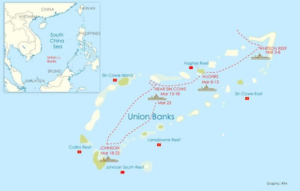In news : Recently, Philippine authorities announced that many of the Chinese fishing vessels that have been moored near the disputed Whitsun Reef in the Spratly Islands
A brief note on the issue
China’s aggressive expansion in the region has found a new ground, Whitsun Reef, where more than two hundred Chinese vessels are currently moored through the area, which comes under the Philippines’ Exclusive Economic Zones (EEZ).
China’s claim
However, China claims the reef under their nine-dash line and says that the vessels stationed since March 7 and are fishing boats seeking refuge during bad weather and not Chinese maritime militia as reported.
What was phillipines response?
The Philippine Coast Guard, however, is not shying away from taking a hard stance. Currently, Philippine military aircrafts and navy are monitoring the situation daily, and China has been warned that there will be an increased military presence to conduct ‘sovereignty patrols’
Previous evidences of China’s aggressiveness
- The Philippines is of the concern that if China is successful with its moves, the Philippines may lose another fishing ground, similar to what happened in 2012 when China took control of Scarborough Shoal.
- In April last year, China sank a Vietnamese fishing vessel and also disrupted Malaysian oil exploration. This prompted the United States to deploy aircraft and navy vessels to assess the situation.
Dispute between China & Philippines over the South China sea
- China and the Philippines, along with other Southeast Asian countries, have long been part of disputes over sovereign claims over the region’s islands, reefs and seabeds.
- Majority of the disputes concern the lack of adherence to the international ‘Exclusive Economic Zones’ which stretch up to 200 nautical miles from the coast of any state. China, especially, has been notorious for disregarding the law on various occasions.
- However, to back its claim, Beijing has long citied the ‘Nine-dash line’, based on unverified historical accounts.
- In January 2013, the Philippines formally led the arbitration proceedings against this claim at the Hague, and in 2016, the court ruled in favour of the Philippines and declared the nine-dash line to be unlawful under the United Nations Convention on the Law of the Sea (UNCLOS).
- But China rejected it as “ill-founded” and continues to maintain presence in the undisputed territories
About Whitsun Reef
- It is a reef at the northeast extreme limit of the Union Banks in the Spratly Islands of the West Philippine Sea.
- Other names of the reef: Whitson Reef and Julian Felipe Reef
- It is the largest reef of the Union Banks

- Area and shape:Whitsun Reef is V-shaped with an area of about 10 km2.
- Until the 1990s the reef was submerged most of the time and was visible above the water only during the low tide.
- At other times the reef could be detected due to the pattern of breaking waves
- Small sand dunes had developed on the reef at end of the 20th century, making a territorial claim possible, because in 2012 an International Court of Justice judgment stated that “low-tide elevations cannot be appropriated”
Nine dash line
- The nine-dash line has been used by China to show the maximum extent of its claim without indicating how the dashes would be joined if it was continuous
- It is used by the People’s Republic of China (China) and the Republic of China (Taiwan), for their claims of the major part of the South China Sea
- The origins of the nine-dash line can be traced back to the official maps made by the Nationalist Kuomintang (also known as the Chinese Nationalist Party) government before and after World War II, according to the book, Asia’s Cauldron, by US scholar and strategist Robert D. Kaplan.
















